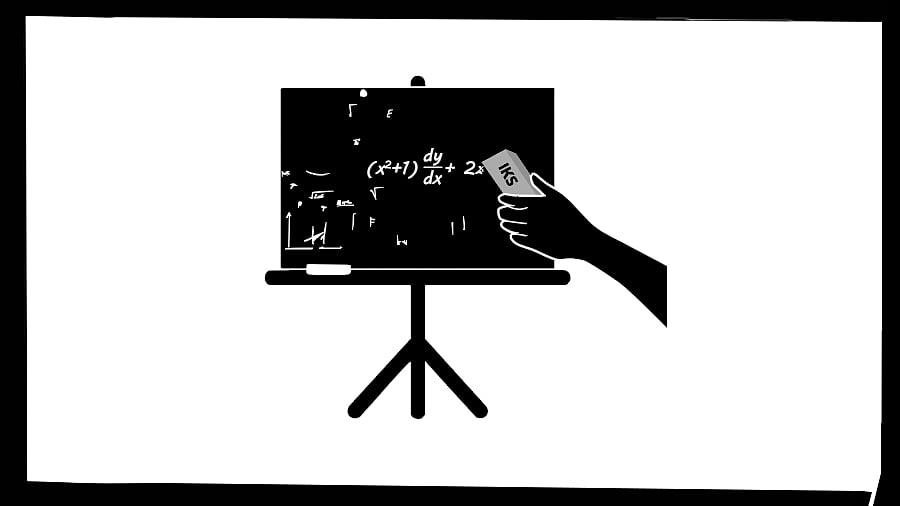
The University Grants Commission’s (UGC) draft Mathematics Curriculum, 2025, unveiled in August, has triggered an unexpected upheaval in India’s academic community. Framed under the National Education Policy (NEP) 2020, the draft promises to create a “forward-looking” syllabus that offers students a “robust foundation in mathematical concepts and skills”. Yet, behind this reformist language lies a troubling imbalance – an excessive tilt towards ancient Indian Knowledge Systems (IKS) that risks eroding the very rigour on which mathematics must stand. At first glance, the draft appears well-intentioned. It proposes a structure for both undergraduate and postgraduate programmes, claiming to align modern mathematics with India’s intellectual heritage.
Its stated goals – value-based education, interdisciplinarity, and integration with the IKS – sound entirely
unobjectionable. But a closer look reveals a pattern of substitution rather than supplementation; it introduces courses that privilege cultural familiarity over analytical training, heritage over abstraction.
Supporters of the new framework claim it offers a holistic blend of classical wisdom and modern science. Core areas like calculus, algebra, analysis, probability, and differential equations remain, alongside electives in computational and data science. A final-year research project for BSc (Honours) students is a welcome move to promote inquiry and research. Yet, the real shift lies elsewhere. The draft introduces courses such as Kala Ganana (traditional timekeeping), Bharatiya Bijganit (Indian algebra),Śulba Sūtras (geometric rules), and Philosophy of Indian Mathematics, with readings from Sūrya Siddhānta and Āryabhaţīyam. Framed as steps towards “decolonising” the curriculum, they signal a philosophical turn – from mathematics as a universal language of logic to a vehicle of cultural identity.
Studying ancient mathematical traditions is valuable, but making them central to the same curriculum as modern analytical mathematics risks diluting conceptual rigour. Sutra-based methods or cosmic time cycles may enrich cultural understanding but contribute little to mastering Linear Algebra, Topology, or Numerical Analysis. Many topics, like the Śulba Sūtras early form of the Pythagorean theorem, are already taught in school. More debatable are the inclusions like Kala Ganana and Pañchāńga which blur the lines between astronomy and astrology. Making them credit-bearing courses undermines disciplinary clarity, leaving students ill-prepared for JAM, NET, or international PG programmes that prize abstraction and proof.
India’s contributions to mathematics are beyond question – from the invention of zero and the decimal system to the pioneering works of Brahmagupta and Bhāskara II. Yet, to honour this heritage meaningfully, it must be understood within the continuum of mathematical thought, not as a substitute for modern discoveries. Brahmagupta’s insights on division by zero, or Bhāskara’s innovations in algebra and number theory, prefigured ideas later explored by Euler, Bernoulli, and Goldbach. These connections belong in courses on the history and philosophy of mathematics, where ideas are studied contextually, not as relics or replacements for analytical reasoning. The question is not whether ancient Indian mathematics deserves inclusion – it certainly does – but how it should be integrated.
To privilege sutra-based instruction or to treat Sanskrit shlokas as proofs confuses cultural pride with scientific education. Mathematics thrives on precision, abstraction, and logical generalisation – qualities vital in today’s technological world. In an era shaped by AI, ML, and data science, India’s students must master Algebra, Analysis, Probability, Differential and Integral Equations, Optimisation, Discrete Mathematics, and Information Theory – the mathematical core needed in forecasting natural hazards, studying climate change, understanding cryptography, and finance. Overemphasising heritage at the expense of such a foundation risks producing graduates rich in nostalgia but poor in analytical power – a loss both academic and economic.
Finding a better balance
A balanced approach is essential. India’s mathematical heritage should be celebrated through electives or interdisciplinary courses linking Mathematics, Sanskrit, History, and Philosophy. Exploring ideas like zero or infinity across cultures can enrich understanding without diluting rigour. Mathematics must stay universal – rooted in proof, abstraction, and precision. Framing it as cultural identity risks reducing a global discipline to symbolism and weakening its analytical foundation.
India’s true mathematical heritage rests on diligence and inquiry, not on rote recitation. Ancient scholars such as Āryabhata, Brahmagupta, and Bāskara were innovators who questioned, calculated, and experimented. To honour them is to uphold their spirit of rational curiosity, not merely chant their formulas. Students may study the Śulba Sūtras, but they must also master vector spaces, partial differential equations, and eigenvalue problems. They should admire Ramanujan’s mathematics while writing optimisation codes or while modelling cancer research. Heritage can enrich education but never replace rigour. Mathematics is a way of reasoning, demanding clarity, consistency, and proof – the very traits that built India’s intellectual past. Abandoning these in the name of revival would betray that legacy.
India stands at a crossroads. One path seeks to turn education into cultural reaffirmation; the other prepares students for a world driven by scientific reasoning. True confidence comes from engaging globally in knowledge creation. A modern mathematics syllabus must preserve rigour, promote research, and inspire innovation. India’s mathematical heritage should enrich, not replace, proof-based reasoning and computational precision.
As the UGC finalises its framework, it must decide whether students will memorise ancient shlokas or design the scope of future mathematics. The answer will shape the roadmap of Indian Mathematics and mathematicians.
(The writer is Principal, Khalisani College, Chandannagar, Hooghly, West Bengal)
Disclaimer: The views expressed above are the author's own. They do not necessarily reflect the views of DH.